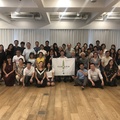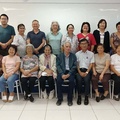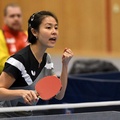For the Japanese language students in Brazil, the beginning of the year is usually the time to wait for the result of the Japanese-Language Proficiency Test (JLPT or Nihongo Noryoku Shiken).
In the country, the exam takes place in early December; the results usually arrive by mail in late January. It does not really take much time, but the report is awaited with much anxiety by the applicants. There is even a saying that “the result of Noryoku Shiken arrives just when you forget about it.”
According to the JLPT official website, the exam is applied in 206 cities in 64 countries outside Japan. According to the organization statistics, in 1984, the first year of application, 4,473 foreign students applied from a total of 7,019 persons. In 2013, there were 441,244 of 571,075.
Originally, the exam was divided into four levels, from N4 (easiest) to N1 (hardest). From 2010, the N5 has been included.
The main reason why students take the Noryoku Shiken is really to evaluate their knowledge of the language.
“I believe that, besides indicating the Japanese level at which the person is, it may help as a certificate for people who want to get scholarships, travel, or work with the Japanese language,” says musician and publicist Daniel Miura, 31 years old, Nisei, approved in N2.
“As for the English language there are the TOEFL and Cambridge to evaluate and validate the knowledge of the language, Noryoku Shiken is important for us youngsters as it is an official document that proves our knowledge,” says Ayaka Sato, 16, Nisei, high school student, approved in N1.
Ayaka’s mother is Japanese, so she had learned Japanese language prior to Portuguese. Later, she started studying with a Japanese native teacher living in Brazil.
In fact, among the Nikkei, it is very common to have some language knowledge acquired at home. “I started to speak Japanese at home and, as I did not know kanji properly, I wanted to learn more,” says high school student Mai Matsui, 14, Sansei, also approved in N1.
The case of Daniel, however, is a little different. “Since my parents are Japanese (Issei), they preferred that I learn Japanese as quickly as possible. So, I studied in a language course (nihongakko), but I attended only for two years,” he says.
When Daniel was a child, his family returned to Japan temporarily. “I knew some loose conversational phrases, but I really learned Japanese there. I was there for a year, when I had attended third grade, in 1992. In the first months, I mixed Portuguese with Japanese. I was only 8 years old, so I guess it was a lot of information for me [laughs],” he recalls.
After returning to Brazil, Daniel maintained the practice of Japanese just by talking with his parents, playing videogames, and reading manga, without formal study.
“It was 20 years since I last applied for the exam, and let it go when I did not pass the N2 in 1995. Only in 2014, I had the will to return, in order to pass the N1. Since I was saving money at that time, I decided to study on my own! I bought some books and took my house’s old dictionary,” says Daniel.
Ayaka, who to this day talks to her family in Japanese, said that to achieve the maximum level, “it was many years preparation. Reading, writing, speaking, and receiving guidance from my mother and teacher.”
Mai also studied by books, with attention to the study of kanji. “For me, the hardest part was reading comprehension, and the easiest was listening,” she says.
In his work as a musician, Daniel points out some peculiarities of the use of Japanese language. “When we write music in Japanese, depending on the audience we want to reach, we have to change the endings of phrases, that forms of treatment, which does not happen much in Portuguese and English. As I have difficulty with kanji when writing, I have to write first in romaji [laughs]. On the other hand, the phonetic of Japanese language makes it much easier to fit in with the notes sung,” he explains.
“Despite returning to studying only last year, it is very important to study not only Japanese, but other languages as well. It is nice to study and learn, there are many information only found in the native language,” he adds.
“As a descendant of Japanese, I think it is particularly important to know, study the language of my origins, whether I use it professionally or not. So, I would like all young people of my age who can study the Japanese language, to do so,” says Ayaka.
In fact, to dominate or at least to be able to maintain a Japanese conversation can bring many benefits and experiences.
“When I traveled to Orlando, we went to a restaurant of a famous chain of department stores. The young man who served us was Japanese and we talked in Japanese. When we said we would return to Brazil, he was startled and said ‘you are not Japanese?’ When I said I was Brazilian, he asked surprised ‘how can you speak Japanese so well?’ At that moment, I felt how important it was to be able to speak Japanese,” said Ayaka.
“Since I practice Japanese traditional dance, my group performs in many places. When we meet Japanese elderly, some only understand Japanese. So we can greet them in their language, and so I think it’s cool,” says Mai.
“The most special moment for me was in 2008, when a friend who worked in a production company called me offering an interpreter job in a interview with Toshi, lead singer of the band X-Japan. Since it was a band I listened to as a child and that also influenced me to form a J-rock band, it was very special! In addition to interviewing him, I could see the show up close!,” recalls Daniel.
Interest in Japanese literature
Thiago de Paula Cruz, 29, writer, first took the Noryoku Shiken in 2014. He calls himself “Brazilian, which involves a mixed ancestry of Africans, Indians, Portuguese, Spanish, and Italian on both sides of the family.”
Thiago was approved in N5, “the most basic of all, but a great achievement for me, as I did not expect to achieve it with only five months of Japanese study.” After studying French, German, English, and Latin, he began a course of Japanese in July 2014.
His special interest in the Japanese language happened by reading Gulliver’s Travels, by Jonathan Swift. &ldquopOne of the trips was exactly to Japan, where there was a description of the persecution of Christians. Upon learning of the existence of many Japanese martyrs, I began to research that period and found Shusaku Endo and shortly after, Ayako Miura,” explains Thiago.
&lquo;What moved me was the will to read literary works of such authors in the originals. Endo has many works in Portuguese and English, but I would like to read in the original form. Miura, in particular, has no text translated into Portuguese and few (rare and expensive) English translations. So, to take full advantage of their art, the only way is learning the Japanese language. To understand a culture, you have to live its language,” he adds.
In his preparation for the exam, Thiago, in addition to the studies in the classroom, used vocabulary lists and grammatical points oriented to Noryoku Shiken. “A reliable evaluation of one’s knowledge of the language opens more doors than to just write in your resume that you master it. It also serves to have a sense of what I need to improve and emphasize the importance of not only a skill (such as conversation) but all the basic skills of the language.”
“pGrammar was a little more complicated than I expected, but it was not very bad. Listening was the most difficult, of course, especially due to the prohibition of taking notes during playback of the dialogue,” he says.
“My knowledge of Japanese is still very limited, but not being completely lost when dealing with texts in Japanese and understanding some small phrases and news is really rewarding,” celebrates Thiago, who plans to achieve N1 in the future and also to get a Ph.D. in literature in Japan.
“There is no doubt that this approval is an extra motivation for me. Now I know that, with great effort, I can learn to truly live the Japanese language and realize my dream to read, understand, and enjoy the works of great Japanese authors in its original language,” Thiago adds.
* Japanese-Language Proficiency Test official website: http://www.jlpt.jp/e/
© 2015 Henrique Minatogawa






